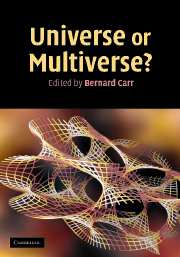Book contents
- Frontmatter
- Contents
- List of contributors
- Preface
- Acknowledgements
- Editorial note
- Part I Overviews
- Part II Cosmology and astrophysics
- Part III Particle physics and quantum theory
- Part IV More general philosophical issues
- 20 Scientific alternatives to the anthropic principle
- 21 Making predictions in a multiverse: conundrums, dangers, coincidences
- 22 Multiverses: description, uniqueness and testing
- 23 Predictions and tests of multiverse theories
- 24 Observation selection theory and cosmological fine-tuning
- 25 Are anthropic arguments, involving multiverses and beyond, legitimate?
- 26 The multiverse hypothesis: a theistic perspective
- 27 Living in a simulated universe
- 28 Universes galore: where will it all end?
- Index
- References
28 - Universes galore: where will it all end?
Published online by Cambridge University Press: 05 July 2014
- Frontmatter
- Contents
- List of contributors
- Preface
- Acknowledgements
- Editorial note
- Part I Overviews
- Part II Cosmology and astrophysics
- Part III Particle physics and quantum theory
- Part IV More general philosophical issues
- 20 Scientific alternatives to the anthropic principle
- 21 Making predictions in a multiverse: conundrums, dangers, coincidences
- 22 Multiverses: description, uniqueness and testing
- 23 Predictions and tests of multiverse theories
- 24 Observation selection theory and cosmological fine-tuning
- 25 Are anthropic arguments, involving multiverses and beyond, legitimate?
- 26 The multiverse hypothesis: a theistic perspective
- 27 Living in a simulated universe
- 28 Universes galore: where will it all end?
- Index
- References
Summary
Some sort of philosophy is inescapable
Most scientists concede that there are features of the observed Universe which appear contrived or ingeniously and felicitously arranged in their relationship to the existence of biological organisms in general and intelligent observers in particular. Often these features involve so-called fine-tuning in certain parameters, such as particle masses or coupling constants, or in the cosmic initial conditions, without which life (at least life as we know it) would be either impossible or very improbable. I term this state of affairs bio-friendliness or biophilicity. Examples of such fine-tuning have been thoroughly reviewed elsewhere [1] and in this volume, so I will not list them here.
It is normally remarked that cosmic bio-friendliness has two possible explanations (discounting sheer luck). One is that the Universe has been designed by a pre-existing creator with life in mind. The other, which is often motivated explicitly or implicitly by a reaction to supernatural explanations, is the multiverse. According to the latter explanation, what we call ‘the Universe’ is but a small component in a vastly larger assemblage of ‘universes’, or cosmic regions, among which all manner of different physical laws and conditions are somewhere instantiated. Only in those ‘Goldilocks’ regions where, by accident, the numbers come out just right will observers like ourselves arise and marvel at the ingenious arrangement of things.
- Type
- Chapter
- Information
- Universe or Multiverse? , pp. 487 - 506Publisher: Cambridge University PressPrint publication year: 2007
References
- 4
- Cited by



